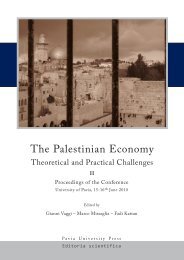Musica che affronta il silenzio - Scritti su Toru Takemitsu - Pavia ...
Musica che affronta il silenzio - Scritti su Toru Takemitsu - Pavia ...
Musica che affronta il silenzio - Scritti su Toru Takemitsu - Pavia ...
Create successful ePaper yourself
Turn your PDF publications into a flip-book with our unique Google optimized e-Paper software.
140<br />
Mit<strong>su</strong>ko Ono<br />
which had a huge influence in Japan, and the “Suntory Hall International Program for<br />
Music Composition”, which continues up to today.<br />
“Music Today” was an international music festival held every year for twenty years,<br />
from 1973 to 1992, under the auspices of the Seibu Department Store in Tokyo.<br />
Takemit<strong>su</strong> planned and organised it every year. A cultural division of Seibu allocated a<br />
regular percentage of sales revenue for this festival: in this they followed the example of<br />
Olivetti in Italy. Takemit<strong>su</strong> himself negotiated with the performers and composers, by<br />
telephone and in writing. It could be said that he had a network of musician friends both<br />
in foreign countries and in Japan.<br />
In this way, the works and composers representative of contemporary music <strong>su</strong>ch<br />
as those that have been featured at “M<strong>il</strong>ano <strong>Musica</strong>” – for example Berio, Cage,<br />
Xenakis, Ligeti or Nono – were introduced to the Japanese public. In addition, Morton<br />
Feldman, Vinko Globokar, Cathy Berberian, Peter Serkin, the London Sinfonietta,<br />
Robert Aitken, Ensemble Tashi, and so on – in all, many composers and performers –<br />
came to Japan in person.<br />
On the tenth anniversary of this music festival, Takemit<strong>su</strong> created an opportunity for<br />
young composers under 35 to have their works played: the “Music Today Composition<br />
Award”. Karen Tanaka, whose work is being performed in 2010’s edition of “M<strong>il</strong>ano<br />
<strong>Musica</strong>”, was one of the composers to receive this prize. 270 composers were introduced<br />
to Japanese audiences in the twenty years of “Music Today” existence; and although this<br />
figure includes Bach, Debussy and Satie, it was mainly the works of contemporary<br />
composers who were so introduced.<br />
Nowadays in the so-called information society, we can obtain vast amounts of information<br />
from overseas eas<strong>il</strong>y and instantaneously. However, at the time when “Music<br />
Today” was held, it was not easy to obtain information on overseas culture in Japan. The<br />
Seibu Department Store which organised “Music Today” had a cinema, bookstore and<br />
record/CD shop atta<strong>che</strong>d, as well as the theatre. Such fac<strong>il</strong>ities were valuable, and were the<br />
only place where the Japanese could obtain information on the world’s contemporary<br />
culture and art. Takemit<strong>su</strong> was involved in the main part of this project.<br />
Takemit<strong>su</strong> not only curated the concerts, but also <strong>su</strong>pervised the publication of Music<br />
Today Quarterly from 1988 onwards. Its editorial motto was ‘to aim at a broad cross-fert<strong>il</strong>ization<br />
between contemporary music, art, and various other disciplines’. It tried to<br />
consider music from every sphere of culture, and considered music globally by including<br />
information about what was happening outside Japan. It was through this magazine, for<br />
example, that I happened to find out about the opera Tieste by Italian composer Sylvano<br />
Bussotti. I remember that the article was written by prof. Luciana Galliano.<br />
Besides “Music Today”, Takemit<strong>su</strong> initiated a new project which was to be held at<br />
Suntory Hall, the first purpose-bu<strong>il</strong>t hall for classical music in Japan. This was the “Suntory<br />
Hall International Program for Music Composition”. For this series, Takemit<strong>su</strong> served as<br />
artistic director. His main responsib<strong>il</strong>ity was the selection of <strong>su</strong>itable composers. He

















